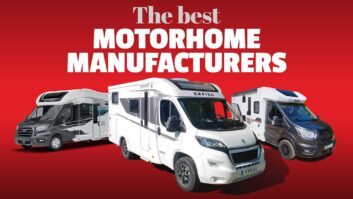Finding the ideal new ‘van isn’t always the most straightforward of processes. Looking at websites, social media and magazines can give you an idea of what models offer, but seeing the ‘van in person and stepping inside to take a good look provides a whole other experience. One of the best ways to do this is heading to a show, where you can browse motorhomes and campervans from the leading names in the industry. If you’re looking for a new model, knowing how to buy a motorhome at a show will be an important factor in getting the most out of your trip.
Shows will have a vast array of models on display, giving you plenty of choice, whether you’re looking for the best small motorhome or the best family motorhome. To set you on your way, we’re offering some advice on how to buy the right ‘van at a show, as well as outlining the benefits of a show and how to get the most from your time there.
1. Why go to a motorhome show?
One of the big advantages of the show is getting to see the layout of the ‘van you’re interested in. For example, let’s say you’ve decided you want your next model to be an island bed motorhome. You will not know just how narrow or short the bed is until you actually lie down on it.
You might have a nearby dealer who stocks the model you’re interested in, but if you want to compare models with a ‘van from a different make, it is almost inevitable that the dealer in question isn’t going to stock both. Then, by the time you’ve sourced where you can see the second model, you won’t be able to remember the exact details of the first one!

This is why a show can be so helpful to ‘van owners. The NEC Shows, for instance, which are held in February and October in Birmingham, will have many of the best motorhome makes in attendance, from UK manufacturers such as Swift and Bailey to Continental brands such as Adria and Hymer.
2. Do your pre-show research
Actually, your work should have started before you attend any show.
Collect brochures. Read the reviews in Practical Motorhome. Go online and see what folk have to say (take extreme views – good and bad – with the proverbial pinch of salt), and talk to friends (or friends of friends) who already own motorhomes.
Take a look at the results of our annual Owner Satisfaction Awards too – this sees the readers of Practical Motorhome and members of The Camping and Caravanning Club vote and let us know how they got on when buying their motorhome, as well as the owning experience, giving us a good insight into the performance of the manufacturer and the supplying dealer.
Quite simply, gather information from as many sources as possible.
At this stage, too, you should start narrowing down the shortlist of models you want to see at any particular event to a manageable size.
Needless to add, do check ahead to ascertain whether the models you want to see will actually be on display at the show you’re planning to visit.
3. Get organised
A bit of planning ahead will prove a massive help on your day(s) out at any show, too.
Even walking around an event can be energy-sapping (here’s a tip: dress for comfort, including a sensible choice of footwear).
Get a show floorplan and plot a route around the show, highlighting which stands you want to visit in particular, so you don’t miss any.

Give yourselves plenty of time, though! You might bump into friends or existing motorhome owners (again, potentially a great source of advice), or you may just like the idea of an occasional sit-down.
By all means use your phone to photograph and/or video any motorhomes you particularly like the look of (you might even want to record your own thoughts at the same time).
But, there’s no substitute for physically writing down the make and exact model details, and what you like and dislike about each model – with so many ’vans to take in, they can all blur into one.
4. Work out what you want
A list of your expectations is another great starting point.
There is a potentially overwhelming amount of choice out there, and what ’van works for you and how you tour is a personal decision that only you can make. What time of year will you be touring in, for instance? If you’re only planning to tour during the warmer months, you can avoid features such as Alde type heating (which increases weight and cost) and could instead get away with a portable option such as the best heater for a campervan. However, if you want the option of touring all year round, it’s worth investing in.
Include anything from overall dimensions and internal layout, to your preferred base vehicle, the MTPLM and specific options.
Deciding which features are must-have items and which are ‘just’ desirable will refine your thinking and help you identify the models that are right for you.
When looking round ’vans, take time to see how different motorhome layouts will work for you.
Everything might look snazzy and shiny under the bright lights of a motorhome show, but will it really work for you on tour?
5. Take your time
Use any show you attend as an ideal research facility. After all, buying a new ’van is a large financial investment and the holiday accommodation that you hope will make your touring dreams come true.
Is this the make, model, layout and floorplan you want? Are the beds long enough? How easy are they to make up? Can you clamber into that drop-down double? Is there enough headroom in the shower? Can you reach the overhead lockers? Is this soft-furnishings scheme right? This is your opportunity to find out!

Don’t feel under any pressure to buy and don’t feel rushed. If there’s something you realise after that you forgot to check, go back and take another look.
6. Stick to your budget
Know exactly what your budget is beforehand – and don’t forget the other bits you’re going to have to cover too, including insurance, essential kit such as a cover, and other items you’ll need to improve your touring experience.
7. Don’t be afraid to ask questions
At any show, even if you think you recognise a dealership’s name, it’s time to turn detective to ascertain things like:
- Where are you from? How long has your company been established under that name?
- Do you work there full-time, and in what capacity?
- How long have you worked here?
- What facilities do you have on your premises (workshops, safe overnight storage etc)?
- What’s the name of your nearest campsite? (Also handy to know if you’re visiting a dealership and want somewhere to stop overnight.)
And never be scared to ask a question – nothing is too basic! And if you forget to ask something, go back.
You’re spending a large chunk of your hard-earned cash on a motorhome, you don’t want to walk away with niggling doubts or worries.
8. Deals at the show
An advantage of buying a motorhome at a show is you will generally find extra accessories are typically thrown in too from both manufacturers and dealers. This can include products such as an awning or other useful items, or even exclusive show-only discounts on the ‘vans that are being sold there.

9. Know what you want but be willing to compromise
Every motorhome or campervan that you see is going to have a compromise in it in some way – finding the ‘perfect’ model without any foibles is unlikely. However, there’s a big difference between a small niggle that you can easily live with and come to forget about compared to something that is going to be an annoyance and has nothing that can be done about it. If the niggle is closer to the latter than the former, it’s probably worth moving on.
10. Dealer locations
If you’re an experienced motorhomer, chances are you’re going to be familiar with a good dealer who isn’t far from where you’re based. In such a case, it’s worth seeing in advance whether they’re going to be in attendance at the show or not.
However, for those who are new to motorhoming, it’s worth finding out where a dealer is based when you speak to them. An excellent deal on a new ‘van is one thing, but if their headquarters is situated a couple of hundred miles from where you are, it’s most likely going to end up being a bad deal for you.
This is because it’s sadly inevitable that something will need rectifying under the warranty at some point, and as a result, would require hours of travel for you to get the work carried out.
A show can also be a great place to see some motorhome dealer specials, ‘vans which are sharply priced and come with useful extras.
Written with contributions from Nigel Hutson and Peter Byrne.
If you’ve enjoyed reading this article, why not get the latest news, reviews and features delivered direct to your door or inbox every month. Take advantage of our brilliant Practical Motorhome magazine SUBSCRIBERS’ OFFER and SIGN UP TO OUR NEWSLETTER for regular weekly updates on all things motorhome related.









